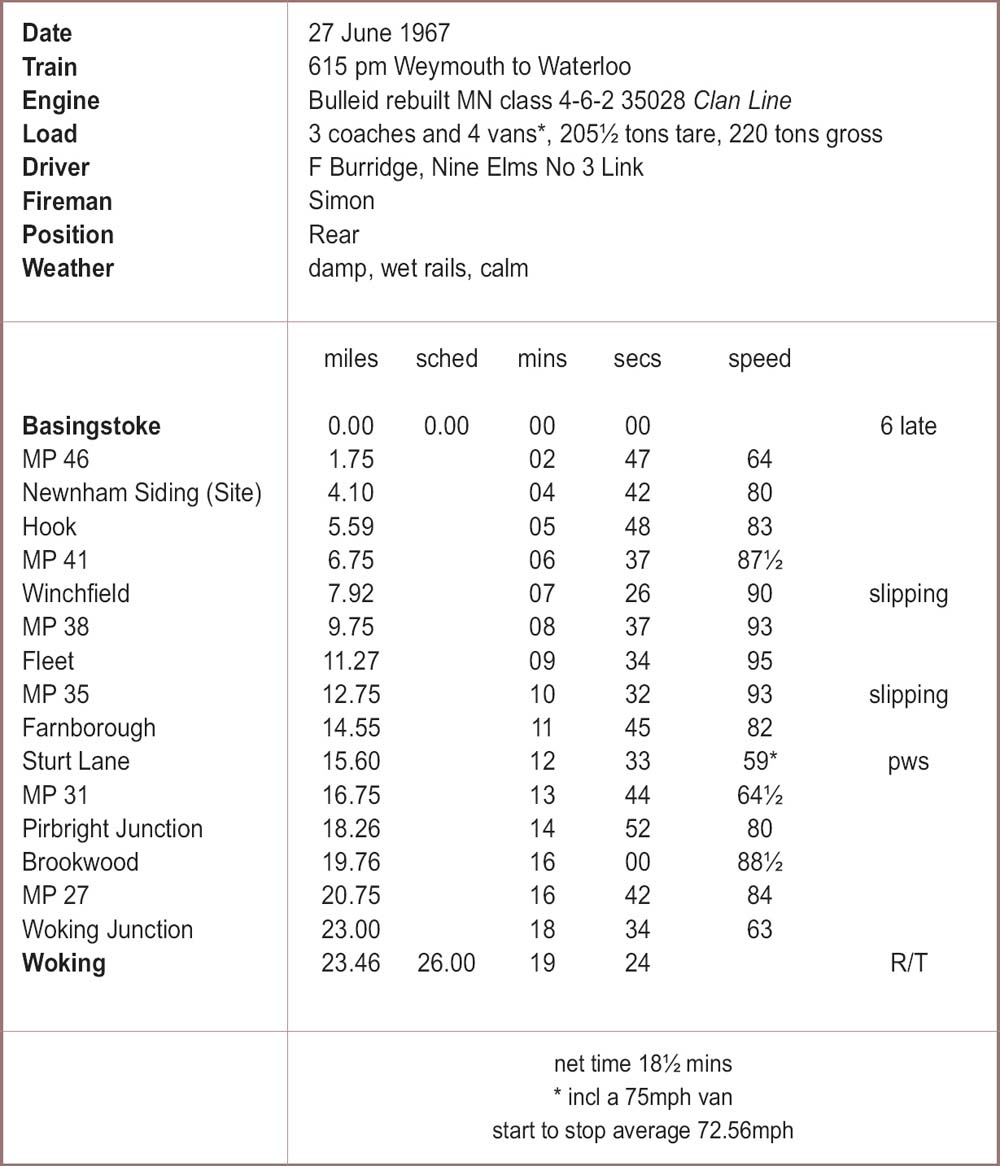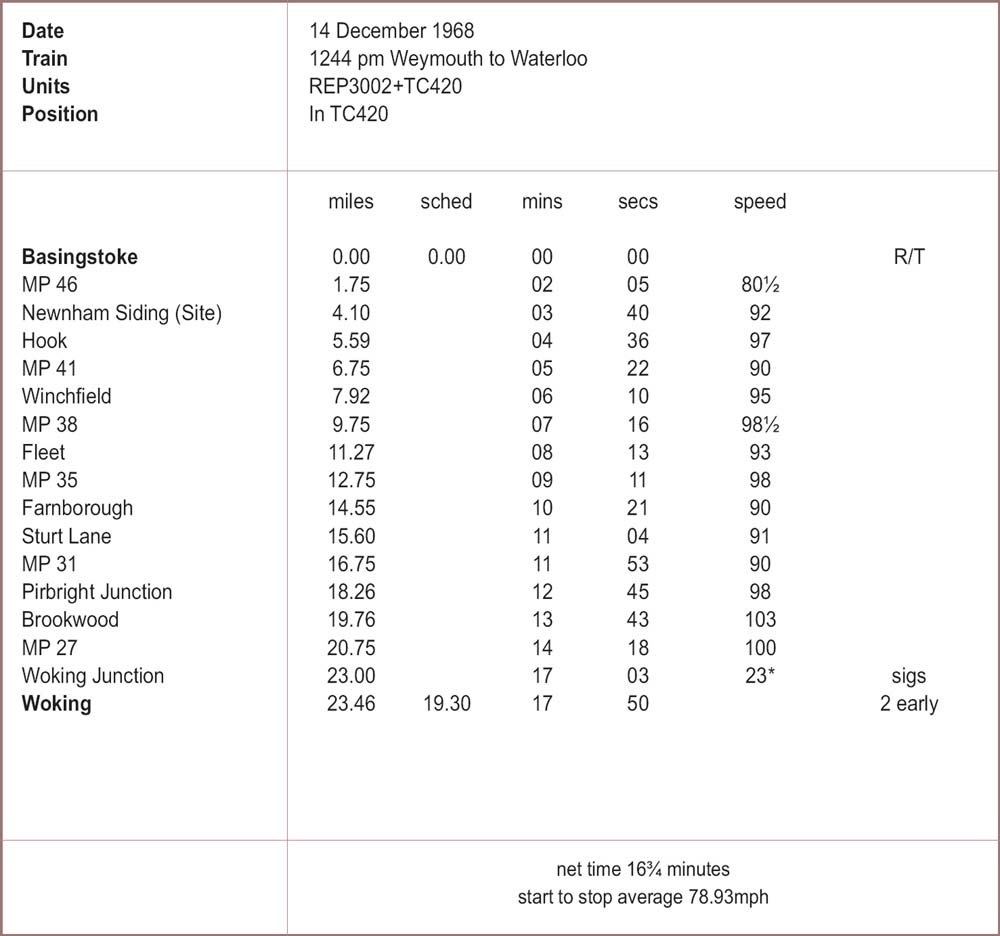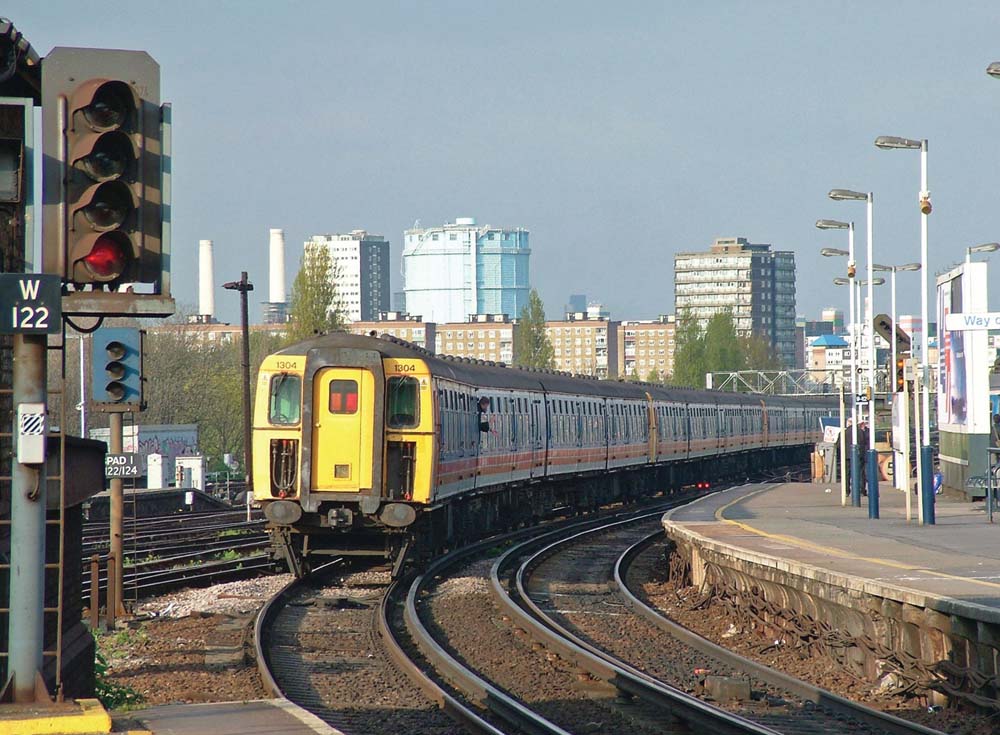

7 May 2015. 444.018 at Woking with a Weymouth to Waterloo train.
“Not that much faster than steam went all those years ago, but oh so much easier to do!”

23 May 1964. 34019 Bideford entering Woking on the 8.46 am Salisbury to Waterloo.
One or two recent fast and unchecked runs on the Basingstoke to Woking section on South West trains’ orderly empire prompted me to look back over the years to see how the quietly competent 444 Desiros compare to past traction and how much progress has actually been made in start to stop times over this favourite racing stretch of mine. (The answer to this question is ‘not much’). Timing trains out of Waterloo started for me in 1960 though it wasn’t until 1964 that I acquired a decent stop watch and therefore produced logs which can be relied on, with some exceptions in 1962 when I was travelling with a suitably equipped friend. GPS was of course a long way off and in fact I still don’t use it much on SWT as the window coating on the Desiros and on some of the 159s prevents the acquisition of a decent signal. Fortunately the tiny LSWR mileposts have largely been replaced or supplemented by large blue posts, though quite a few of these are misplaced. As far as possible the photographs are taken at Basingstoke or Woking or at points in between and show either the locomotive or unit featured in the logs or one of the same class.

27 June 1964. 34102 Lapford passing Vauxhall with the 5.54 pm Waterloo to Basingstoke local.
So we start with Table One with Bulleid light Pacifics hauling heavy loads. And the two runs demonstrate the relative ease with which mile-a-minute runs could be achieved with decent loads, though full or nearly full regulator would have been needed. Earlier Sullivan had taken 34019 over Roundwood at a very respectable 55mph from the Winchester start.

27 June 1964. 34001 Exeter passing Vauxhall on the 11 am Padstow to Waterloo.


11 April 1964. 34004 Yeovil passing Woking at speed with an up Ocean Liner Express.

30 March 1964. Fireman Les Hoath awaits the right away from Woking on 34009 Lyme Regis working the 9.30 am Waterloo to Bournemouth.



11 June 1964. Standard 5 73171 near Wimbledon on the 7.02 pm Clapham Junction to Eastleigh vans.
Table Two is a selection of my many high speed dashes with light Pacifics with fairly light loads and shows just what steam could achieve. There is no doubt in my mind that a 20 minute booking would have been practical with engines in their prime but the fact is that these times were all set toward the end of steam with run down engines. The run with Lyme Regis in particular required very little effort. The Lapford run though was a very different proposition as John (Boy) Gaffney set out to try for the ‘ton’ and just achieved it, after Bramshott at the foot of the half mile of 1 in 655 down. The noise was absolutely incredible with the engine being worked in full regulator and 40 per cent cut off. This run has also appeared elsewhere with a maximum speed shown of less than 100mph. However I knew this stretch of line like the back of my hand and had a set routine always taking readings at the same quarter mileposts to ensure both consistency and to avoid the misplaced posts. My milepost readings fully support the speeds shown.
Table Three shows some good, competent runs behind BR Standard class 5s with reasonable loads plus one of a couple I had with a Standard Class 4 2-6-0 on quite a good load. Salisbury could and did turnout almost anything for the 6.35 pm up, but 76066 was a little underpowered so this was a good effort.
And finally with steam in Table Four one of the high speed Merchant Navy efforts in 1967. This shows that the current DMU and EMU bookings could have been kept with steam. And that’s with the condition that these engines were in by the end. There were a number of runs over this stretch where the Merchant Navy Pacifics reached and exceeded 100mph and these are dealt with in my forthcoming book on the untold story of the last two years of steam on the Southern.



20 June 1964. 73088 at Basingstoke on the 12.53 pm local to Waterloo.

13 July 1963. 76017 approaching Woking with the 1.01 pm Salisbury to Waterloo stopping service.


Table Five shows some runs with the immediate replacements for steam, the innovative REPs and TCs, which were a good solution at the time but only because the extra cost of electrification right through to Weymouth couldn’t be justified. For many years the first run in Table Five was my fastest on this stretch though I didn’t venture into this part of the world so much in the years following the end of steam due to marriage and then work commitments. The REPS were fine units and could produce some lightning accelerations if working with just the single TC unit.
Then we had the Warship era on the Exeters, followed in the late 1980s by the magnificent Class 50s with the Type 3 ‘Cromptons’ on some of the semi-fasts. Most of the latter were push-pull with a single TC unit, but my favourite trains were the two which had MK 1 stock and decent loads. What can one say about the 50s? They were superb machines capable of very fast running and starts to rival the EMUs. The run with 50.023 benefitted by having one coach less than normal and turned in a net time equal to my fastest with a 444, and twenty-five years separate these forms of motive power! They were however non-standard and unreliable so didn’t last.
Then came the class 73 EDLs during the transition period when the REP traction motors were being taken to be used in the new 442s and some interesting train formations could be found. The run in Table Six was nine coaches, including a 5 car TCB buffet set with the two 73s stretching the 90mph limit for these engines and was a joy to time. This was part of a booked non-stop run from Southampton Parkway to Waterloo. The overall time was 61 minutes and 16 seconds or 56 minutes net for the 74.83 miles. Today there are no bookings anything like as fast, though in my view there ought to be.

3 June 1963. 35028 Clan Line near Pirbright with the 9.21 am Weymouth to Waterloo.

28 February 1986. REP 3005 leading TC418 on the 9 am Bournemouth to Waterloo approaching Basingstoke.



10 March 1988. 33.110 near Pirbright with the 7.16 am Salisbury to Waterloo.

22 April 1988. 50.018 at Old Basing with the 5.50 am Exeter to Waterloo.



27 September 1987. 33.051 near Old Basing with the 10.05 am Southampton Docks to Waterloo QE2 Ocean Liner Express.

10 March 1988. 33.119 on the 8.10 am Waterloo to Salisbury.

20 April 2005. Class 442 No 2415 on the 15.05 pm Waterloo to Poole at Winchester.


22 April 1988. 73.129 at Old Basing on the 6.54 am Bournemouth to Waterloo.



12 December 2006. Class 442 No 2405 on the 11.05 am Waterloo to Poole passing Woking.

24 March 2005. Greyhound CEP 2315 leaving Basingstoke with the 11.09 am Waterloo to Portsmouth Harbour.



1 April 2005. CIG 1890 on arrival at Basingstoke with the 10.57 am from Brighton.

1 April 2005. VEP 3401 at Basingstoke on the 12.09 pm Waterloo to Portsmouth Harbour.

20 April 2005. Greyhound CIG 1304 trailing the 15.51 pm Portsmouth Harbour to Waterloo at Clapham Junction.
For various reasons I didn’t cover the 442 era very much, but in my opinion these units are probably the finest ever to run on Southern Rails and it’s fitting that they continue in use today on the Brighton line, where they receive my attention from time to time and where they still appear to have a future post-Thameslink upgrade. Table Seven shows some runs with these fine units.
Table Eight brings us into the CIG/CEP era, albeit at the end. The stopping pattern of the Bournemouth line trains now meant that it was quite difficult to get a train with Basingstoke and Woking stops in its journey as most of the faster services were Winchester to Woking or Basingstoke to Clapham Junction. The Greyhound units, both CIGs and CEPs had an extra stage of field weakening and so could run faster than the standard units. In theory this should not have affected the starts but seemed to nevertheless, and the time to MP 46 with 1313+1319 is amongst the fastest I have ever recorded. The 100mph at Pirbright with 1316+2315 was superb and I must admit to letting out a muffled shout of joy at this at-long-last realised ambition with MK 1 EMU, only ever equalled in December of the same year with a non-Greyhound CEP on the steep downhill section at Hildenborough with the CEP Farewell Tour.

And so to the current scene which, since our move away from East Sussex to be near Southampton, has meant much easier access to trains with the Basingstoke and Woking stopping pattern. The 159s (Table Nine) perform well but the 18 minute standard booking is very tight if the 90mph limit is observed and with the usual signal check approaching Woking if running on time. Our favourite train for trips to London during the week is the 9 am from Southampton and it is this train with its 444+444 formation which has given me my two fastest Basingstoke to Woking start to stop times shown in Table Ten, the 16 minutes 21 seconds being a Railway Performance Society fastest time of recent years.
To achieve sub 16½ minutes means a fast start, preferably at least 2 minutes late and a good finish with running as close to the 100mph limit as possible, which both these runs did. I estimate that the theoretical fastest time possible within the laid down speed limit is about 16 minutes 10 seconds, not that much faster than steam went all those years ago, but oh so much easier to do!

24 March 2005. Cab of Greyhound CEP 2315 at Waterloo.